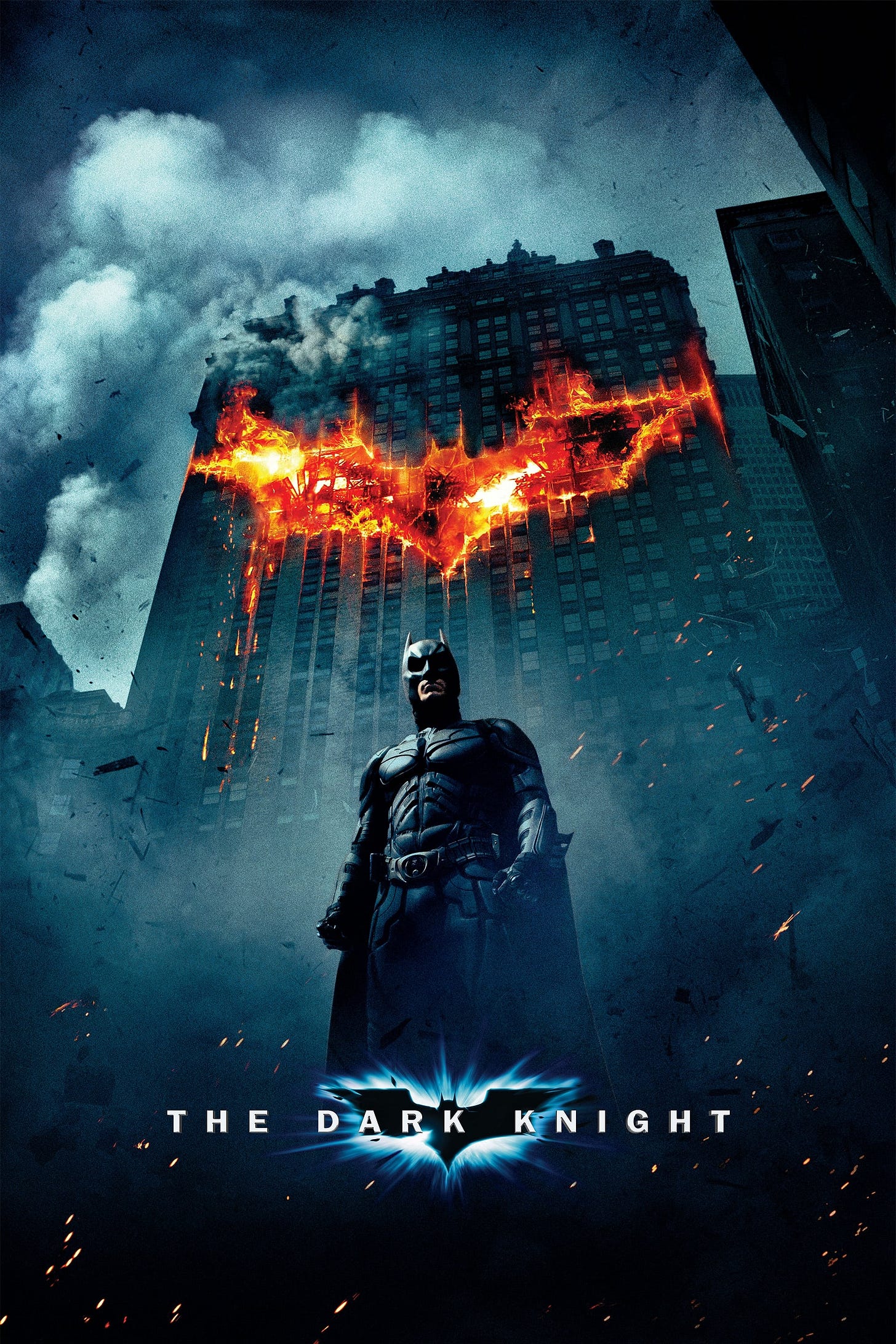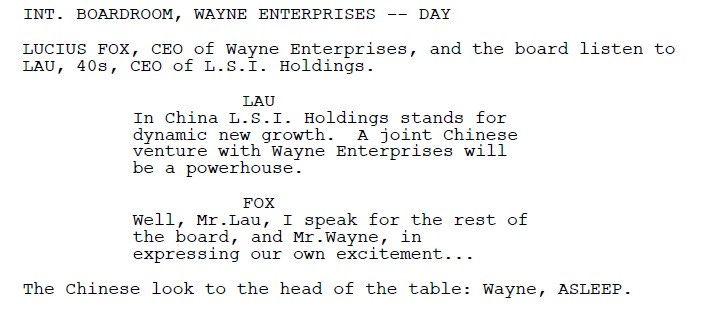The Dark Knight (2008) Script Review | #26 WGA 101 Greatest Scripts of the 21st Century
A gritty urban crime drama take on the iconic comic book character, a rare superior sequel in cinematic history, and an all-round great superhero movie.
Logline: Aided by Lieutenant Jim Gordon and District Attorney Harvey Dent, Batman goes after the remaining crime mobs of Gotham. Although their partnership initially proves effective, Batman soon finds himself treading a fine line between heroism and vigilantism when the Joker throws the city into chaos.
Written by: Jonathan Nolan and Christopher Nolan
Story by: Christopher Nolan & David S. Goyer
Based on: Batman, created by Bob Kane and Bill Finger
Pages: 140
The Dark Knight transcends the superhero genre, hewing closer to a gritty urban drama than a traditional comic book story with costumed characters running around and fighting. It’s a script that actually tries to grapple with weighty ideas, such as the cost of fighting evil, while delivering entertainment. It is bold, personal, daring, and tragic.
It’s also the first—and so far, only—story in which Batman is more of a supporting character than the lead; in terms of an emotional arc, he doesn’t really change. The real protagonist is Harvey Dent, a good man destroyed by his circumstances. The screenplay by Jonathan Nolan and Christopher Nolan acquires the flavor of a Shakespearean tragedy, where the main character’s flaw undoes him by the end, with the supporting characters left to comment on the aftermath (the titular characters in Hamlet, Othello, Macbeth, and King Lear die before the play ends). That doesn’t stop it from being a hell of a good time.
Since saving Gotham City, Batman has relentlessly pushed the city’s organized crime factions up against the wall. Thanks to Batman’s efforts, District Attorney Dent and Lieutenant Jim Gordon are close to cleaning up corruption and ushering in a new age of law and order to Gotham. But when the mob unleashes the Joker on the city, Batman and his allies find themselves tested at every turn by a man who embodies pure chaos.
Whether by design or by accident, The Dark Knight echoes the downbeat turn of events in The Empire Strikes Back— the bad guy wins, the good guys lose, it ends on a cliffhanger, and there’s two major deaths. Even though Batman succeeds in apprehending the Joker, he’s too late to prevent the Clown Prince of Crime from driving Dent towards the darkness; Dent’s death is covered up as a murder by Batman to prevent Dent’s crimes from undoing all the work they have done. Even the climax forgoes a traditional all-out battle in favor of something more intimate: a moral dilemma and a fist-fight, where Batman has to stop the Joker from blowing up two ferries, and then stop Dent from killing Gordon’s family. Talk about subverting expectations.
The script is light on description. The writing is short and often terse, using plenty of hyphens and ellipses to convey the sense of continuous motion. The script moves fast'; you can feel it in the pacing. Even big moments such as a helicopter being taken down…
… and a truck being flipped in the middle of the street moments later are summed up in a few lines.
Another advantage of a sequel is that you don’t have to spend a lot of time reintroducing and establishing characters like Bruce Wayne, Alfred, Lucius Fox, and Rachel.
The Dark Knight opens with a big action sequence that introduces us to the Joker robbing a bank, following the template of a James Bond movie in which you kick off with a bang. After such a bold introduction, the Joker won’t reappear again until page 26, in which he re-enters the story in dramatic fashion (though the dialogue is different; more on that later).
The structure is as such:
Act 1: Batman and his allies are readying to move in on the mob and arrest CEO Lau, the guy laundering their money, but face a setback when Lau flees to Hong Kong; the Joker offers to kill Batman but is rejected. (Pages 1-30)
Act 2: Batman abducts Lau and brings him back to Gotham; the mob accepts the Joker’s offer. The Joker begins to wage a psychological war on Gotham by killing citizens daily until Batman turns himself in. After some scrapes, the Joker is captured but he has Dent and Rachel Dawes kidnapped and strapped to bombs. Batman fails to save Rachel, half of Dent’s face is burnt in a fiery explosion, and the Joker escapes. He tells the mob that he is running Gotham now, and begins to create panic in the city. (Pages 31-97)
Act 3: Batman resorts to desperate measures to track down and apprehend the Joker. At the same time, Dent is persuaded by the Joker to take matters into his own hands instead of trusting the law and systems, prompting the District Attorney to go after the corrupt cops, mobsters, and ultimately, Gordon’s family. Dent is killed in a fall, Batman takes the blame for Dent’s death, and flees into the night. (Page 98-140)
When talks of a sequel to Batman Begins started to become reality, Nolan thought about how the Joker might be interpreted in his realistic take on the Batman universe. He imagined that Batman would have planned to hang up the cowl in a few years after taking down the mob, only to keep pushing that day further and further away. He was also intrigued about the Harvey Dent character, and how the idea of heroism grew devalued in a post-9/11 world.
As with Batman Begins, Nolan and David S. Goyer (who received a ‘Story by’ credit) also drew from the source material for inspiration. Specific titles like Batman: The Long Halloween were a big influence; on a broader scale, Batman comics from the 1980s and Frank Miller also influenced the story. But Nolan didn’t stop there; he drew from other films, too. Michael Mann’s crime film, Heat, was a major influence, as was Mabuse, the Gambler; while the shark in Jaws was used in their approach of depicting the Joker as a relentless, unstoppable force. Moreover, as Nolan sat down to work on the sequel, he was haunted by an image of Batman being hounded by the police; this would serve as the script’s closing moments.
Nolan’s garage once again became the base of operations for cracking the story. For three months, Nolan and Goyer would map out the main plot points on index cards and developing the essential characters. After helping out uncredited on Batman Begins, Jonathan Nolan would take point on the early drafts of the script, which Christopher Nolan found nailed the characterization of the Joker but was filled with impracticalities. Once Nolan finished The Prestige, he took over writing duties. Over the next six months, the Nolan brothers would work through various drafts, developing the story on taxis, planes, and in various countries even as the film inched towards pre-production.
Even though he was building on the work established in the reboot, Nolan treated The Dark Knight almost as a quasi-reboot of its own. Sequels are expected to scale and go bigger because that’s what the audience expects. But the Nolans and Goyer wanted to tackle scale in a different way. If Batman Begins operated on the template of a classic hero’s journey, then The Dark Knight would function as an urban crime drama. If Batman Begins spanned a number of geographical locations, then The Dark Knight would- apart from a brief sojourn to Hong Kong- keep Batman in Gotham but expand the geography of the city. One daring idea was to put Batman in a dilemma where he’d be forced to choose to save one person over another. Another was to take that dilemma and expand it into a showdown for the third act climax; we can thank Jonathan Nolan for coming up with the showdown in which one ferry has to choose to blow up another ferry before they are both blown up by the Joker, as well as Batman working against Gordon to save a group of hostages. Interestingly, Christopher Nolan protested against the approach, later admitting that cutting between the Prewitt building and the ferries shouldn’t have worked.
Jonathan Nolan can also take credit for the immortal line that becomes the script’s driving theme: “You either die a hero or you live long enough to see yourself become the villain.” Succinct, memorable, and encapsulates the thematic underpinnings of The Dark Knight. As Goyer said in an interview, “We had Batman on one side, saying that Harvey Dent represents a good vision of what the city can become, and then we had the Joker on the other side, saying that any man can by corrupted and turned into a villain if you push him hard enough. And the Joker is kind of right, which is why we wrote an ending in which Batman and Gordon conspire to hide that truth from Gotham. They protect the image of Harvey Dent, and Batman sacrifices himself.”
When it comes to the Joker, the writers have created a villain for the cinematic and pop culture ages. A cunning adversary with no background, the Joker carries a Hannibal Lecter-esque quality in his amorality and ruthlessness. However, this script also reflects Nolan’s collaborative approach with actors— the dialogue here doesn’t have the same punch as they would in the final film. That’s because the late Heath Ledger, who portrayed the character, took what the script offered and spun them in a way that made it infinitely better. It goes to show that no matter how good it looks on the page, it can always be improved when turning the words into reality.
Sequels are tough, especially when the first film is a success. It’s even riskier when you decide to shift the main character journey from the franchise’s main character to another. The Nolans pull this off by keeping Batman true to himself and, even though he doesn’t undergo a major emotional change, changing the status quo by the end (he starts a hero and ends up falsely accused as a villain); meanwhile, Dent gets the emotional journey (he starts a good man and ends up a villain). By bringing in personality and ideas that occupied Nolan, The Dark Knight surpasses its predecessor to be a riveting sequel. There’s nothing quite like it in a genre that is barely distinguishable from every other offering.
Notes:
Shone, Tom (2020) – The Nolan Variations: The Movies, Mysteries, and Marvels of Christopher Nolan
Jesser, Jody Duncan; Pourroy, Janine (2012) – The Art and Making of the Dark Knight Trilogy
Hibberd, James (March 29, 2024) | Jonathan Nolan Explains the Origin of ‘The Dark Knight’s’ Most Famous Line (The Hollywood Reporter)
Interview: Christopher Nolan: The Movies. The Memories. (Empire)
Thompson, Anne (July 6, 2008) | Dark Knight Review: Nolan Talks Sequel Inflation (Variety)









